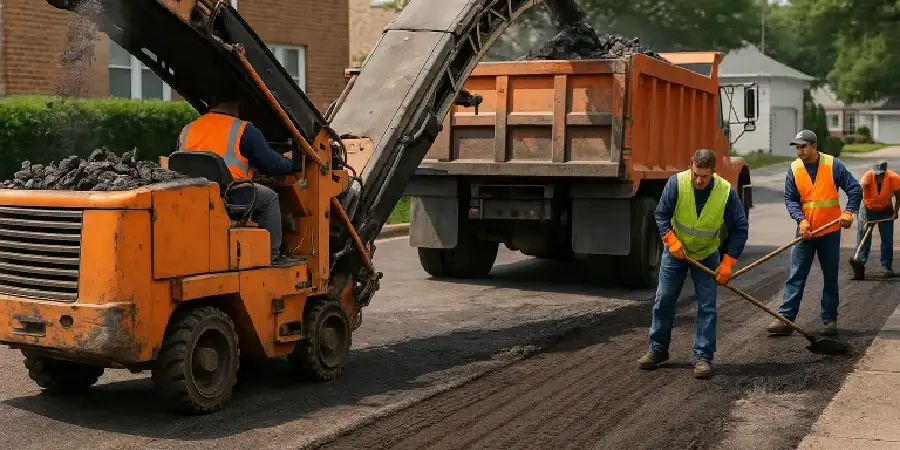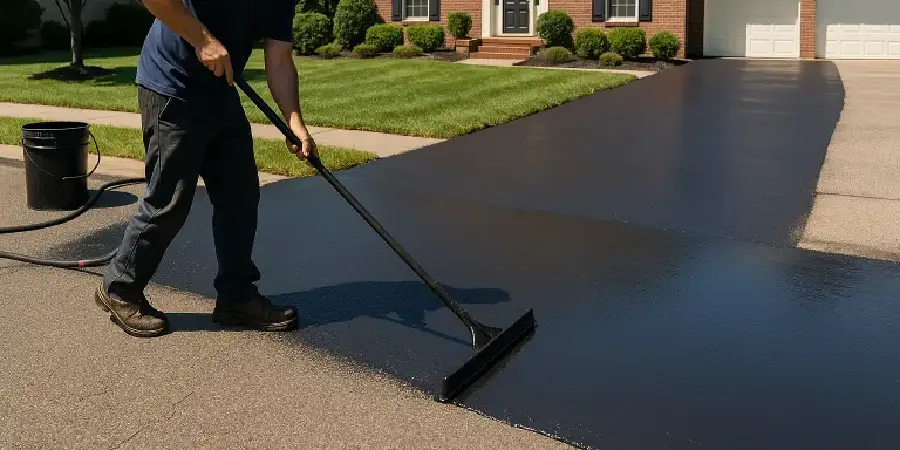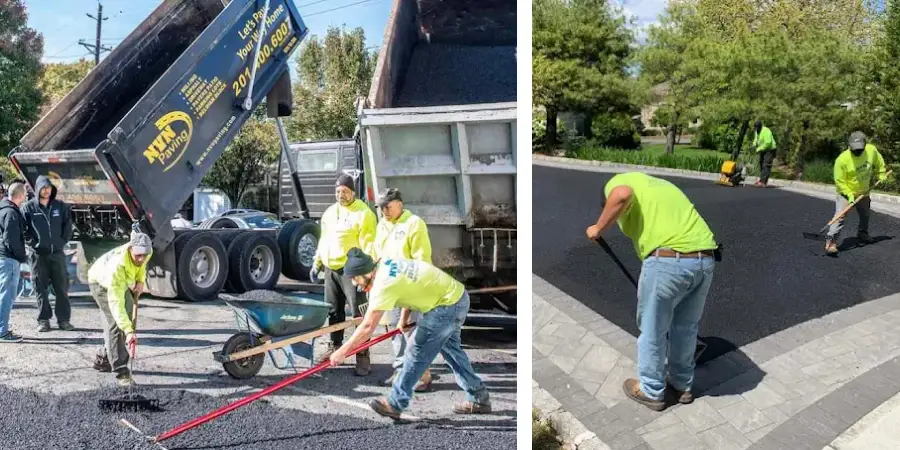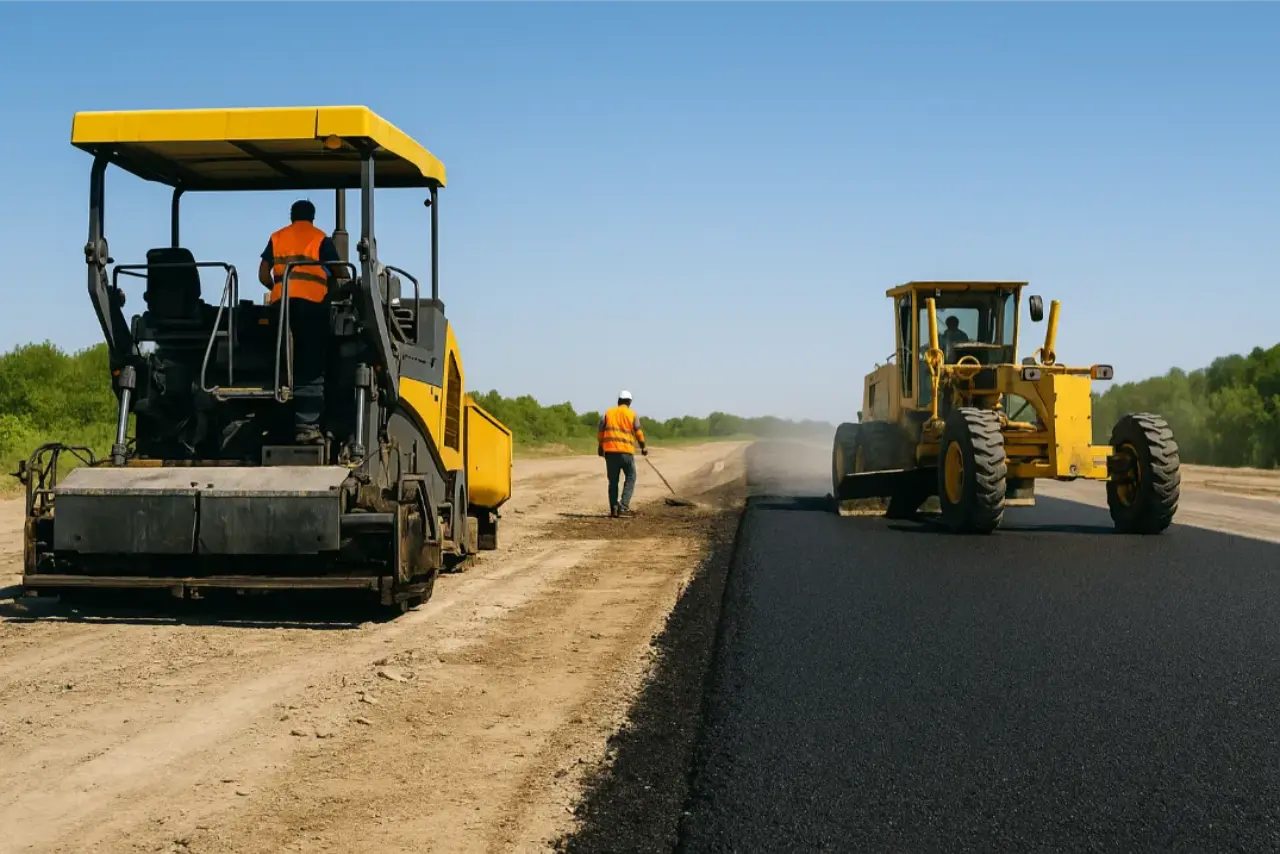When you step onto a smooth driveway or park in a freshly paved lot, you’re standing on the result of a detailed asphalt pavement installation process.
Blacktop, also called asphalt, remains the top choice for homeowners and commercial property owners in 2025.
This guide explains the asphalt paving process step by step and shows how each stage contributes to long-lasting pavement.

Site Preparation: Building a Solid Foundation
Every project begins with proper site preparation.
Experienced asphalt contractors clear away debris, vegetation, and old asphalt to prepare a clean slate.
Automatic motor graders help establish a proper slope to encourage water drainage.
Without this step, even the best materials can’t provide a solid foundation.
For professional asphalt paving services, experts ensure drainage, slope, and proper compaction are addressed from the start.

Removing the Existing Surface
The asphalt installation process starts with demolition.
Old asphalt or concrete must be removed so the new surface asphalt has a firm base to bond with.
Dump trucks haul away debris, while compaction equipment levels the area.
This step is critical for both driveway paving and larger commercial projects.

Sub Base Layer and Sub Base Installation
Next comes the sub-base layer, one of the most critical steps in asphalt pavement installation.
It provides load support, prevents shifting during freeze-thaw cycles, and acts as a frost barrier.
Sub-base installation typically uses crushed stone or bridge base materials compacted into place.
The thickness of the sub-base depends on several factors, including soil stability, climate, and expected traffic loads.
Contractors in Somerset County specialize in ensuring the sub-base layer is built to last (see local paving services).
Proof Roll for Strength
Once the sub base is compacted, the right contractors perform a proof roll to test its durability.
A roller truck passes over the entire surface to expose weak spots.
Soft areas are repaired with additional base materials.
This ensures the sub base forms a solid foundation capable of handling future traffic loads, especially in parking lot paving projects.

The Asphalt Binder Layer
With the sub base complete, an asphalt binder layer is installed.
This step uses larger aggregate particles mixed with asphalt binder to create structural strength.
Acting as the glue between the sub base and the top asphalt layer, the binder adds durability.
For Bergen County jobs, local paving contractors emphasize binder quality to maximize performance.
Base Layer and Compaction Equipment
The base layer is compacted with vibratory rollers and advanced compaction equipment.
Reducing air void content is crucial for durability, as too much air weakens the surface.
Every 1% increase in compaction can extend pavement life by 10%.
Local paving contractors also ensure lift thickness is consistent, preventing weak spots in the new pavement installation.

Installation Process of Hot Mix Asphalt HMA
The most visible part of the paving process is applying hot mix asphalt.
Delivered by dump trucks at a precise mix temperature, the hot mix is spread evenly in layers.
Each lift thickness is monitored closely to achieve the proper thickness across the job site.
This careful step defines the quality of the final asphalt paving project.
Tack Coat and Butt Joints
At transitions, butt joints are created so the top asphalt layer blends seamlessly with adjacent roads or driveways.
A tack coat may also be applied between layers to ensure adhesion.
Skipping this step could cause separation and water infiltration.
If damage does occur, emergency asphalt repair services can provide quick fixes.

Final Roll and Final Compaction
The last step in asphalt pavement installation is the final compaction.
A roller truck smooths the surface asphalt, locks in the asphalt layer, and eliminates air voids.
This final roll creates a surface that can withstand both residential use and the heavy demands of commercial property owners.
Curing the New Asphalt Surface
Fresh asphalt needs 24–48 hours to cure. During this period, heavy machinery vehicles should be avoided.
The curing process allows the pavement to harden and form a durable surface asphalt.
Passaic County businesses often schedule paving strategically to reduce disruption (see local paving contractors).

Sealcoating for Longevity
A few months later, sealcoating protects the new asphalt pavement installation from UV rays, oil, and water.
This step is key for extending the lifespan of both driveways and parking lots.
Sealcoating services in NJ are widely recommended for both residential and commercial property owners.
Maintenance Tips for a Long-Lasting Pavement
To maximize your investment:
- Inspect your pavement regularly.
- Seal cracks early.
- Schedule sealcoating every 3–5 years.
- Ensure proper water drainage with a consistent slope.
Routine asphalt maintenance helps avoid costly repairs and ensures a long-lasting pavement.
Asphalt Paving Work for Parking Lots
Parking lots require stronger asphalt paving work than residential driveways.
The asphalt pavement installation process for these spaces involves thicker sub-base layers, more binder, and stricter attention to air void content.
NVN’s parking lot services cover grading, installation, and sealcoating for commercial property owners.
Recycled Asphalt for New Paving Projects
Many new paving projects today use recycled asphalt.
This eco-friendly option lowers costs and reduces waste while still delivering a durable asphalt surface.
Recycled asphalt is popular in both residential driveways and parking lots, as it promotes sustainability.

Choosing the Right Team for Your Asphalt Paving Project
Selecting experienced asphalt contractors ensures your paving project runs smoothly.
Look for companies with specialized equipment, a proven track record, and a focus on high-quality materials.
Morris County paving contractors are known for reliable service and strong results.
Blacktop Paving Process FAQs
What is the process for asphalt paving?
It includes site preparation, removing the existing surface, sub-base installation, binder layer, hot mix asphalt, compaction, curing, and sealcoating.
What do you put down before asphalt?
A sub-base layer and a binder layer are placed to provide a solid foundation.
Is there a difference between asphalt and blacktop?
Yes. Blacktop usually has more aggregate particles, making it ideal for driveways, while asphalt pavement is used broadly in both residential and commercial projects.
How often should you sealcoat asphalt?
Every 3–5 years, depending on climate and use.
How much does it cost to pave a 2,000 sq ft driveway?
In New Jersey, prices usually range from $8,000 to $15,000 depending on site conditions, recycled asphalt use, and drainage.
Several factors influence the total, including traffic loads, soil type, and slope.
Always get a detailed estimate before starting.
Conclusion: Asphalt Surface Requires Laws of Physics
The blacktop paving process is a carefully managed series of steps that ensure durability, safety, and performance.
From sub base installation to the final roll, every stage contributes to success.
Whether it’s a driveway, parking lot, or larger asphalt paving work, choosing skilled contractors ensures your investment is protected.
With sealcoating, maintenance, and recycled asphalt options, your surface will deliver reliable performance for decades.
